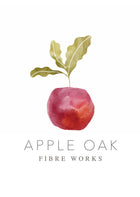ORGANIC COCHINEAL DYE
COCHINEAL DYE ~ Dye colours red, pinks to purples
Origin: Canary Islands, Spain. Organically farmed and processed by Canaturex
I am so delighted to have finally found some organic Cochineal. Lorenzo is one of the very first offering fully traceable Cochineal grown to organic principals.
Cochineal, a powerful dye sourced from tiny insects that feed on cacti, produces stunning shades of purple, red and pink. With just one dye bath, this incredible insect can create a range of hues, from deep, rich reds to delicate, fairy-like pinks. It is derived from the Dactylopius species of insects, and its body contains 19-22% carminic acid.
*To make one kilogram of cochineal dye, it takes about 80,000 to 100,000 insects.
Excellent colour fastness is guaranteed.
---------------------
Recipe for Wool Fibres: Downloadable PDF
Recipe For Plant Fibres: Downloadable PDF
Basic recipe:
6% Cochineal
Wool yarn mordanted with Alum 10%
Soak Cochineal in Water overnight
blend using a stick blender
Add dye to dye bath
Bring to a simmer
Remove any black tar like bubbles
Strain through a cloth and keep to the side
Add yarn to bath simmer for one hour.
Add dye bag to second and any following dye baths.








MYROBALAN ~ Natural Tannin ground & whole
MYROBALAN CHEBULIC ~ a tannin used for (pre) mordanting cellulose (Cotton, Linen) Fibres. Recipe below.
ORIGN: India
Myrobalan is a very common tannin used in India and around Asia. It creates a plum-like fruit from various trees of the genus Terminalia, formerly used in medicine as a mild laxative and now used in the dyeing industry.
Myrobalan creates butter yellow on fabric, like most tannins. Tannin is important for mordanting cellulose fibres like cotton and linen. Alum alone is not a suitable mordant for cellulose fibres and its use will produce inferior colours.
Myrobalan can be used in print, over dye with indigo for teal, use as a stand alone colour or as a mordant.
***********************************************
Recipe Downloadable PDF for creating Greys and Charcoal
Basic recipe for mordanting cellulose fibres:
A 2 step process, please read through the entire instructions first.
Step 1:
Ingredients:
10% Myrobalan (10% of the weight of fabric (w.o.f.))
1.Fill a plastic or stainless steel vessel with hot water (40-50 d. Celsius/100-120F) to a 30:1 ratio (water : fabric)
2. add tannin and stir until dissolved or evenly distributed
3. add fabric, immerse fully for 1-2 hours. The bath will cool down, which is totally fine. Stir occasionally.
4. use rubber gloves when removing fabric, squeeze fabric. Rinse very lightly or better spin it out using a centrifugal spinner or washing machine. Tannin is bound to the fibre only by affinity and can be removed if rinsed aggressively.
5. save mordant for future use.
6. don't let it dry before moving to the 2nd mordanting step.
Step 2:
Ingredients:
Alum 12% (w.o.f.) Dissolved in enough boiling water, cool.
Soda Ash 1.5% (w.o.f.) Dissolve in enough boiling water, cool.
1. Combine the two solutions while stirring. It will bubble, so make sure your vessel is big enough.
2. Bubbles will subside quickly and you should be left with a clear liquid. Add additional hot water as described above. Follow steps 3 - 5 from above.
3. Rinse the textile well, to make sure any unattached mordant is rinsed off.
4. The textile may be dyed immediately or dried for future use.
Tips:
*Too hot and the tannin will oxidize, which is fine, if you want a potentially darker colour. For overdyeing, it is best to keep the colour as light as possible.
** You can also use cold water instead of hot, but it will require a 12h soak at least.
***Any tannin can be used with this recipe, but for lighter results use Oak Gall or Tara.
Enjoy!
Join The Natural Dyers & Growers Academy to share your experiences and get support from fellow growers.










